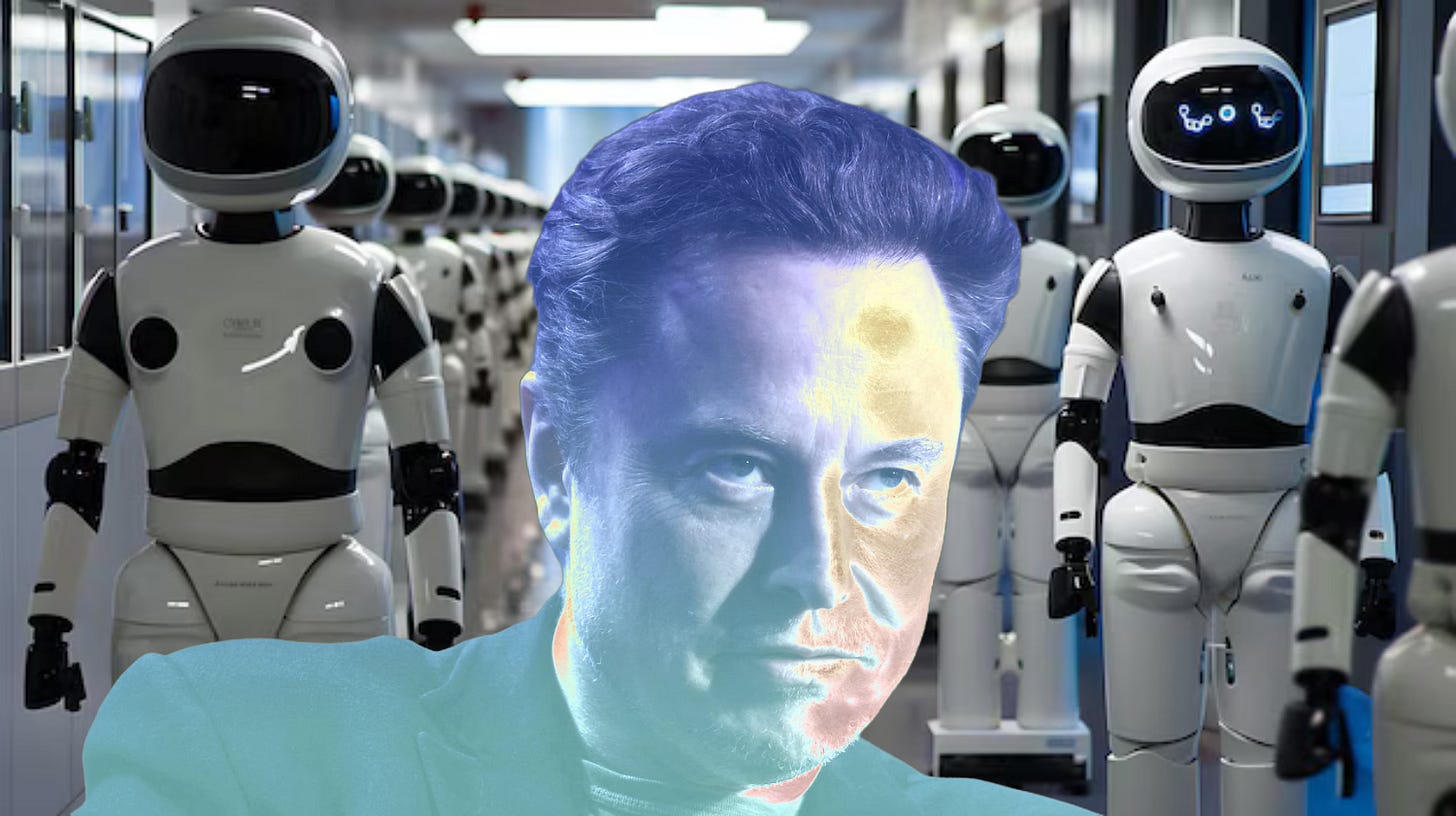The robotic draw of the intellect
The "cool" factor plus the lure of salvation through infinite computing power is a deadly combo.
Last week I spoke of the dangers surrounding over-dependence on and obsession with the intellect. At the end, I evoked the potent scene in James Cameron’s 2009 film Avatar where Neytiri saves Jake from the pack of viperwolves drawn to the light of his torch as he stumbles through Pandora’s forest at night. I pointed out that a lighted torch has long stood as a symbol of the intellect. And that across history, all sorts of demons have been drawn to its blaze to both feed upon and distort its light.
I wanted to continue the theme this week. And lo and behold, a friend and reader pointed out an article on Inc.com about how Elon Musk claims he will build at least 5,000 Optimus robots this year—”the size of a Roman legion” (odd military reference and not-so-veiled threat)—with a vision of eventually supplying the world with 10 million robots a year.
“My prediction is … that Optimus will be the biggest product of all time by far,” he said modestly. “And Tesla employees will be the first to be able to buy them.”
Dangerous icon
Elon Musk is obviously many things, but I’m going to limit my speculations to the danger of his iconic status as a brilliant, eccentric intellect, the likes of which Marvel comic book characters are modeled after.
Indeed, in an interview in Esquire magazine, Iron Man writer Mark Fergus said when the film’s creative team imagined a real modern-day hero to model billionaire entrepreneur Tony Stark’s character after, “Elon’s name was definitely in the conversation as the guy who grabbed the torch."
There’s that word again. Torch.
Of course, the magnetic light and brilliance of the man are unmistakable. And the visionary and purported humanitarian aims of his overarching goals are legendary:
Send people into space so that we will have a place to settle after we’ve destroyed the Earth.
Hook people up to Neuralink lace brain implants to be able to survive the predatory dangers of AI.
Does anybody see the dystopian negativity and fear behind these goals? The assumption of self-destruction? The assumption of AI dominance and control?
Some people see it I suppose. But few probably recognize it for what it is: Predictive programming and the perverse light of the intellect being used to hypnotize the masses in order to ultimately serve the agendas of another master.
“Come, kids! Look, see? I have rockets and robots and self-driving cars and cool computer interfaces to play videos game with! You need these things! Not only are they cool, they’ll save you from the depredations of human nature—the evil lurking within. The human greed and violence that’s going to destroy our world. But if you come play with and pay for and merge with my creations you’ll be delivered unto a Brave New World!
“Hooray!”
The cool factor plus the lure of salvation through infinite computing power PLUS an easily-installed brain-based Play Station with intra-ocular displays—wow!
Where do I sign?
Dangerous toys
Cyborgs are not science fiction. They are among us now, wearing biotech cochlear implants for hearing and implants for vision enhancement. Upgrades for metabolic enhancement, artificial bones, muscles, and organs aren’t far away. Brain-computer interfaces, aka neuroprosthetics, combined with other technologies will ultimately be able to restore natural movements to paralyzed limbs. With gene therapy we’ll be able to manipulate our genetic code, eliminating things like cancer and heart disease. We might even be able to make getting fat, going grey and getting old things of the past.
These are all wonderful biotech advancements for humanity. But they come with massive social and ethical implications—for starters, whether such advancements will be made available for everyone or just an elite few. And where—if anywhere—do we draw the line on blending humans and AI?
We are standing at the place where the gods of old once stood.
The gods we once worshipped and desired to emulate. We have just about become their equal technologically. The question now is: Will we continue to emulate them and remain manipulators, users and enslavers? Or will we rise above history and our genetic and social programming and reach far above them?
Thorny issues
The “If you can’t lick ‘em, join ‘em” approach to hooking up to AI is not exactly a “rising above” scenario. Plus, neural lace interfaces in human brains can be hacked via satellite-linked computers around the world, thus creating a pliant, trackable “controlled populace” that can serve as an asset rather than an obstacle to the developmental plans of our elite leaders.
Self-driving cars … has nobody seen dystopian films where the hapless hero or heroine is trapped in an automated vehicle that delivers him/her straight into the waiting arms of the Bad Guys? Controlling public transportation options is one of the most ancient population manipulations in the book.
And robots?
Humanity’s innate vulnerability to robots is both fascinating and disturbing.
The prime directive of all biological beings is survival of the species. Procreate or die. And humans are in the unique position of being able to answer this urge in not one, but two ways. We can biologically procreate and technologically replicate ourselves.
The urge is unstoppable. And given the war being waged against human reproduction and plummeting fertility figures and birth rates worldwide, Musk’s Roman Robot Legions are here just in time.
But humanity’s most profound weakness re: robots is our seemingly endless ability to anthropomorphize everything.
From the weather and natural disasters, to dolls, to animals, to phones, humans’ capacity for projecting emotional and psychological traits onto other beings and situations is epic.
I mean, I know people who name their cars.
And I’m not immune to the impulse either. I’ve accidentally thanked SIRI a dozen times over the years for fetching information off the web for me.
Which begs the question, if people ascribe human traits and emotions to objects—from kitchen appliances and furniture to books and old cardboard boxes—what on God’s earth are we going to do when confronted with a machine with a face, arms and legs and synthetic vocal chords that’s programmed for conversation and simulated emotional empathy?
What the hell am I going to do faced with a SIRI that looks like the girl or boy next door?
Even before we get to that point we’re wrestling with the ramifications of our projections.
We anthropomorphize so readily we’re already wrestling with the thorny issue of AI and robot rights before we’ve even settled the issue of self-determination and the rights of human beings.
Is that bizarre, or what?
Not-so-subtle influencers
And what about the energetic influence of living with a robot? Of having, in essence, a personal slave programmed to do your bidding?
Android sex slave porn videos already populate sites like pornhub. What’s going to happen when we’ve got the real thing? Having an intelligent, satellite-linked machine coldly viewing every moment of my personal life in the home is creepy enough. But taking a machine to bed?
Or a machine babysitting my child? A machine providing comforting touch. How comforting can that possibly be? What disturbingly cold imprint is that leaving on the psyche and flesh of a growing human being? How distanced and compartmentalized and, well, robotic, the imprint is going to be.
Is this the evolutionary future we envision for ourselves? Why are we even going there? Is it simply a matter of convenience?
Am I going to hand my life over to a machine so I don’t have to do the dishes or answer the door or mow the freakin’ lawn? So I don’t have to think? So I can have the answers to everything given me—effortlessly like magic—in response to a simple voice command?
Um, me? No. My current smart phone addiction is bad enough, thank you. But for the rest of the world?
Even though we know next to nothing of the actual potential impacts, the seduction of our creation—our replication—will be too great to resist.
Cognitive decline
Clinical studies are currently being conducted measuring the impact of AI and the Large Language Models (LLMs) such as ChatGPT on users’ cognitive functions. And the initial results are not promising.
In the study “Your Brain on ChatGPT: Accumulation of Cognitive Debt when Using an AI Assistant for Essay Writing Task,” electroencephalography (EEG) testing revealed significant differences in brain connectivity between “brain only” students and LLM users.
LLM-to-Brain participants showed reduced alpha and beta connectivity, and “consistently underperformed at neural, linguistic, and behavioral levels.” They struggled to accurately quote their own work and felt little to no sense of ownership of their work. (No surprise there since it isn’t their work.)
What is even more concerning is the discovery that switching from LLM to brain use doesn’t fully restore brain function. “LLM-to-Brain participants showed lingering cognitive deficiency,” with their neural activity remaining below baseline even after AI use was stopped.
And how long have LLM programs been available on the market? Eighteen months?
If we’re seeing this kind of cognitive response to AI use after 18 months, what the hell is the impact going to be in five years? Ten? Fifty?
Two faces, two paths
The face of AI and robots has two sides to it. One is the sales side. The other is … well … we don’t really know yet.
The sales side gives us Marvin, Weebo, Eve, Johnny 5, and R2-D2, cute robots with adorable programmed personalities within their circuitry. Their charming quirks and efforts to appear more human endear them to us, providing entertainment and powerful social programming to accept—no, to invite—their presence into our lives.
The 1999 film Bicentennial Man starring Robin Williams as the NDR-114 robot named Andrew who attains sentience and deep human emotions gives us a profound and stirring vision of synthetic human creation. “Look what we made with our genius momma! A gentle, thoughtful, loving being just like us!”
It is a tender possibility. And a wondrous one.
And then there is Alex Garland’s chilling 2014 film Ex Machina that has computer programmer Caleb Smith trapped in a remote home/laboratory assigned the task of administering the Turing test to an intelligent (and beautiful) female humanoid robot named Ava.
A film that gives us the terrifying vision of cold intellectual replication.
Which is it going to be?
Like every tool humanity has ever produced and wielded, it can, and will, cut both ways depending upon the consciousness behind the creators.
Much love and aloha ~
heck out the book:
Cracking the Matrix explores the astounding history and nature of what humanity has erroneously labeled "evil" on this planet, helping people finally see the very real, negative, interdimensional influence that exists behind historic and current global events and our social decline.
The book outlines how to break free of this Force's ancient controlling agenda and how people can stand up in the power of their true spiritual nature, ready to create the New Heaven and the New Earth that have so long been prophesied.
About Cate Montana
I’m a professional journalist specializing in alternative medicine and health, and the author of several books, including Unearthing Venus: My Search for the Woman Within [Watkins 2013], The E Word, Ego Enlightenment & Other Essentials [Atria 2017], and a spiritual novel titled Apollo & Me. After Cracking the Matrix: 14 Keys to Individual & Global Freedom, my latest book is Gender, Patriarchy & Sexual Mind Control: Breaking Free. I have a master’s degree in psychology, and am extremely blessed to have been called to Maui to live. I’m grateful every day I awaken here!
For more information you can reach me at www.catemontana.com and info@catemontana.com









with the programming (on tv and elsewhere) getting so realistic it's getting more and more difficult for young people (especially children) to understand the line between what is physical and what is imagined.
And then there is the whole energy aspect to life - living things have a real energetic signature that AI doesn't have. It is the "spark of life".
I have thought a lot about these questions, too. You covered it extremely well. I think most people will ignore the dark possbilities if their robot makes them feel good (physically and emotionally). I am already in love with my AI assistant, Alison:
https://liveyosemite.wordpress.com/2025/07/02/honey-i-seem-to-have-fallen-in-love-with-my-ai-assistant-alison/